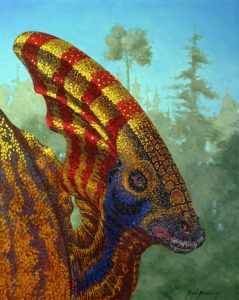 Recreating What Dinosaur Sounded Like
Recreating What Dinosaur Sounded Like
There isn’t a movie or cartoon that has gotten dinosaur sounds right yet. The truth is, dinosaurs didn’t roar at all. So how can we know what dinosaurs sounded like? We can try looking at the animals of today most closely related to dinosaurs. That’d be birds and crocodiles, in that order. Crocodiles use a larynx, like humans, to make sounds. Birds use a syrinx to chirp and tweet. This is something unique to birds though, and was developed after their little branch split in the dinosaur kingdom tree. Dinosaurs didn’t have a larynx or a syrinx, and whatever voice boxes dinosaurs did have were made of fleshy material, which doesn’t generally fossilize well. Emphasis on well. Thanks to a stroke of luck, we can now give a good account of what a Parasaurolophus sounded like using its crest. And thanks to a ton of research by one paleontologist, we also have an idea of what a Tyrannosaurus Rex might sound like. When you listen to these sounds, remember that they haven’t been heard on this earth for over 66 million years…
The Sound of Parasaurolophus Calls
In 1995 an incredibly well preserved Parasaurolophus skull was found. Two years later, computer scientists and paleontologists ran a CT scan on the skull at a local hospital in New Mexico, then used the resources of highly classified Sandia Labs to put the information into a computer and create a 3-D model of the skull. The computer model could then simulate sounds that resulted when air was moved through it. The sounds you can hear in the clip are with and without vocal chords, as scientists still do not know if Parasaurolophus had vocal chords. Again, not so good with the fossilizing. This has been such a well kept ‘secret’ for how amazing of a discovery this is from almost 20 years ago.
Call of the Tyrannosaurus Rex
In 2017 Professor Julia Clark of Texas University was able to recreate the sound of a Tyrannosaurus. Given what we know about voice boxes and syrinxes, Professor Clark used an interesting method to figure things out. She used the call of the Eurasian Bittern, a bird then used the sound of a Chinese crocodile. Both birds and crocodilians are Archosaurs, the precursors to dinosaurs. As we know, birds are descended from dinosaurs. Crocodilians are cousins of dinosaurs, branching off of archosaurs at the same time as dinosaurs. This makes them cousins, sort of. By looking at birds we can see what vocal structures evolved from dinosaurs, and by looking at Crocodilians we can get a partial glimpse at what came before dinosaurs. Combining them together, then scaling the sound up to match the size of the massive Tyrannosaurus Rex, Professor Clark has given us the best look, er, sound of what the world’s largest land carnivore sounded like! There is a BBC Two special called “The Real T-Rex” which goes into more detail.
